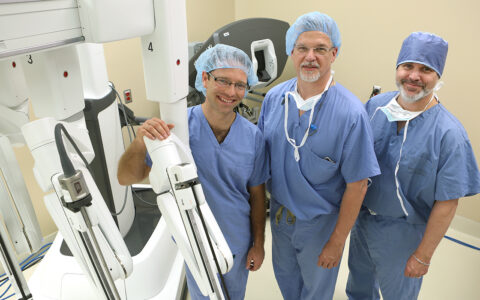Nearly 60 percent of men who receive a low-risk prostate cancer diagnosis now opt for a “wait-and-see” approach, up from just 16 percent less than a decade ago, according to the latest numbers published in JAMA Internal Medicine.
The climb suggests urologists are adopting clinical guidelines that recommend active surveillance for low- and some intermediate-risk cases, said first author Bashir Al Hussein Al Awamlh, M.D., a urologic oncology fellow at Vanderbilt University Medical Center.
“Patients and physicians are increasingly becoming more comfortable with observing a subset of cancers with low-risk features, extending the benefits of surveillance to more men.”
“Patients and physicians are increasingly becoming more comfortable with observing a subset of cancers with low-risk features, extending the benefits of surveillance to more men,” he said.
Joining Al Hussein Al Awamlh for the massive analysis was his research mentor, Daniel Barocas, M.D., executive vice chair of urology at Vanderbilt University Medical Center.
Supporting Informed Decisions
For decades, Vanderbilt researchers have worked to inform treatment decision-making by churning out data on the comparative benefits of radiation, surgery and active surveillance for different types of prostate cancers.
Their landmark CEASAR study analyzed long-term, quality-of-life outcomes stratified by treatment approach. In that study, surveillance offered fewer patient-reported urinary, bowel and sexual side effects than active treatment, despite the presence of prostate cancer.
Barocas says active surveillance is appropriate for patients with “low-risk prostate cancer, who commit to serial prostate-specific antigen assessments and repeat biopsy.”
All patients benefit from involvement in shared decision-making with their provider, he added, noting that digital tools are now available to help guide the conversation. An informed choice is essential to minimize patient regret, whether due to clinical outcomes, treatment costs or shifts in quality-of-life.
Uptick in Surveillance
To understand current trends, Al Hussein Al Awamlh and colleagues analyzed the NCI’s Surveillance, Epidemiology and End Results Prostate with Watchful Waiting database. The researchers included men older than 40 years, with low-risk or favorable intermediate-risk prostate adenocarcinoma from 2010 to 2018. In total, data from 105,802 men were included.
The researchers found that even among favorable intermediate-risk cancers, active surveillance rates nearly tripled between 2010 and 2018, rising from 7.8 to 21.8 percent.
While more patients are benefitting from active surveillance, for low-risk prostate cancer the rates still lag behind Sweden (74 percent by 2014) and Australia (67 percent by 2016), the authors wrote.
At Highest Risk
The analysis also found evidence of disparities, corroborating other research by the team. Active surveillance was less common among groups that included men of Hispanic descent and Asian/Pacific Islanders when compared to white males. Men living in rural settings were also more likely to undergo definitive treatment, whether surgery or radiation.
Barocas says this could indicate men in certain groups may not have been offered the option of active surveillance. He also notes higher income was associated with active surveillance.
“We would like to see the rising tide of active surveillance lift all boats,” Barocas said.
Screening may also impact surveillance rates as techniques become increasingly sensitive.
“We would like to see the rising tide of active surveillance lift all boats.”
Among patients with low-risk disease, the study found two or more positive biopsy cores caused active surveillance rates to drop by nearly 50 percent, as compared with only one positive core, even though these men were still eligible for surveillance.
“This is worrisome, particularly with the increasing use of magnetic resonance imaging in biopsy, which may bias toward more positive cores and potentially higher rates of downgrading at prostatectomy,” the authors wrote.





